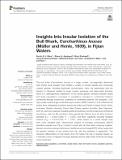Por favor, use este identificador para citar o enlazar a este item:
http://hdl.handle.net/10261/236377COMPARTIR / EXPORTAR:
 SHARE SHARE
 CORE
BASE CORE
BASE
|
|
| Visualizar otros formatos: MARC | Dublin Core | RDF | ORE | MODS | METS | DIDL | DATACITE | |

| Título: | Insights Into Insular Isolation of the Bull Shark, Carcharhinus leucas (Müller and Henle, 1839), in Fijian Waters |
Autor: | Glaus, Kerstin B. J.; Appleyard, Sharon A.; Stockwell, Brian L.; Brunnschweiler, Juerg M.; Shivji, Mahmood; Marie, Amandine D.; Rico, Ciro CSIC ORCID | Palabras clave: | Island populations Connectivity Coastal sharks Shark reef marine reserve Population genomics Dispersal barriers |
Fecha de publicación: | 14-dic-2020 | Editor: | Frontiers Media | Citación: | Frontiers in Marine Science 7: 586015 (2020) | Resumen: | The bull shark (Carcharhinus leucas) is a large, mobile, circumglobally distributed high trophic level predator that inhabits a variety of remote islands and continental coastal habitats, including freshwater environments. Here, we hypothesize that the barriers to dispersal created by large oceanic expanses and deep-water trenches result in a heterogeneous distribution of the neutral genetic diversity between island bull shark populations compared to populations sampled in continental locations connected through continuous coastlines of continental shelves. We analyzed 1,494 high-quality neutral single nucleotide polymorphism (SNP) markers in 215 individual bull sharks from widespread locations across the Indian and Pacific Oceans (South Africa, Indonesia, Western Australia, Papua New Guinea, eastern Australia, New Caledonia, and Fiji). Genomic analyses revealed partitioning between remote insular and continental populations, with the Fiji population being genetically different from all other locations sampled (FST = 0.034–0.044, P < 0.001), and New Caledonia showing marginal isolation (FST = 0.016–0.024, P < 0.001; albeit based on a small sample size) from most sampled sites. Discriminant analysis of principal components (DAPC) identified samples from Fiji as a distinct cluster with all other sites clustering together. Genetic structure analyses (Admixture, fastStructure and AssignPOP) further supported the genetic isolation of bull sharks from Fiji, with the analyses in agreement. The observed differentiation in bull sharks from Fiji makes this site of special interest, as it indicates a lack of migration through dispersal across deep-water trenches and large ocean expanses. | Descripción: | © 2020 Glaus, Appleyard, Stockwell, Brunnschweiler, Shivji, Clua, Marie and Rico. | Versión del editor: | http://dx.doi.org/10.3389/fmars.2020.586015 | URI: | http://hdl.handle.net/10261/236377 | DOI: | 10.3389/fmars.2020.586015 | E-ISSN: | 2296-7745 |
| Aparece en las colecciones: | (ICMAN) Artículos |
Ficheros en este ítem:
| Fichero | Descripción | Tamaño | Formato | |
|---|---|---|---|---|
| Insights_Glaus_PV_Art2020.pdf | 1,25 MB | Adobe PDF |  Visualizar/Abrir |
CORE Recommender
SCOPUSTM
Citations
6
checked on 22-abr-2024
WEB OF SCIENCETM
Citations
4
checked on 24-feb-2024
Page view(s)
59
checked on 22-abr-2024
Download(s)
107
checked on 22-abr-2024
Google ScholarTM
Check
Altmetric
Altmetric
Este item está licenciado bajo una Licencia Creative Commons

